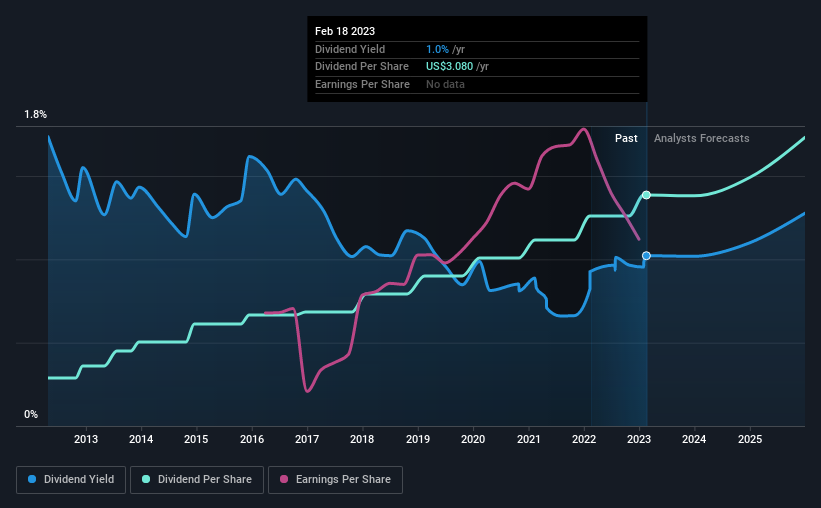Moody's Corporation (NYSE:MCO) Looks Interesting, And It's About To Pay A Dividend
It looks like Moody's Corporation (NYSE:MCO) is about to go ex-dividend in the next four days. The ex-dividend date is one business day before the record date, which is the cut-off date for shareholders to be present on the company's books to be eligible for a dividend payment. The ex-dividend date is an important date to be aware of as any purchase of the stock made on or after this date might mean a late settlement that doesn't show on the record date. Accordingly, Moody's investors that purchase the stock on or after the 23rd of February will not receive the dividend, which will be paid on the 17th of March.
The company's next dividend payment will be US$0.77 per share, on the back of last year when the company paid a total of US$3.08 to shareholders. Looking at the last 12 months of distributions, Moody's has a trailing yield of approximately 1.0% on its current stock price of $301.45. If you buy this business for its dividend, you should have an idea of whether Moody's's dividend is reliable and sustainable. As a result, readers should always check whether Moody's has been able to grow its dividends, or if the dividend might be cut.
Check out our latest analysis for Moody's
Dividends are typically paid out of company income, so if a company pays out more than it earned, its dividend is usually at a higher risk of being cut. That's why it's good to see Moody's paying out a modest 37% of its earnings.
Generally speaking, the lower a company's payout ratios, the more resilient its dividend usually is.
Click here to see the company's payout ratio, plus analyst estimates of its future dividends.
Have Earnings And Dividends Been Growing?
Companies with consistently growing earnings per share generally make the best dividend stocks, as they usually find it easier to grow dividends per share. If earnings decline and the company is forced to cut its dividend, investors could watch the value of their investment go up in smoke. This is why it's a relief to see Moody's earnings per share are up 7.4% per annum over the last five years.
Many investors will assess a company's dividend performance by evaluating how much the dividend payments have changed over time. In the last 10 years, Moody's has lifted its dividend by approximately 17% a year on average. It's encouraging to see the company lifting dividends while earnings are growing, suggesting at least some corporate interest in rewarding shareholders.
To Sum It Up
Is Moody's worth buying for its dividend? Moody's has seen its earnings per share grow slowly in recent years, and the company reinvests more than half of its profits in the business, which generally bodes well for its future prospects. We think this is a pretty attractive combination, and would be interested in investigating Moody's more closely.
While it's tempting to invest in Moody's for the dividends alone, you should always be mindful of the risks involved. Every company has risks, and we've spotted 2 warning signs for Moody's (of which 1 doesn't sit too well with us!) you should know about.
A common investing mistake is buying the first interesting stock you see. Here you can find a full list of high-yield dividend stocks.
Have feedback on this article? Concerned about the content? Get in touch with us directly. Alternatively, email editorial-team (at) simplywallst.com.
This article by Simply Wall St is general in nature. We provide commentary based on historical data and analyst forecasts only using an unbiased methodology and our articles are not intended to be financial advice. It does not constitute a recommendation to buy or sell any stock, and does not take account of your objectives, or your financial situation. We aim to bring you long-term focused analysis driven by fundamental data. Note that our analysis may not factor in the latest price-sensitive company announcements or qualitative material. Simply Wall St has no position in any stocks mentioned.
Join A Paid User Research Session
You’ll receive a US$30 Amazon Gift card for 1 hour of your time while helping us build better investing tools for the individual investors like yourself. Sign up here

 Yahoo Finance
Yahoo Finance 
